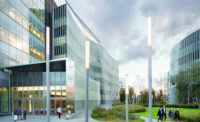Craig Thomas Discovery and Visitor Center
Bohlin Cywinski Jackson seizes on Grand Teton's natural drama with the elegant Craig Thomas Visitor Center.
Architects & Firms
Moose, Wyoming
There’s nothing formulaic about the National Park Service’s new Craig Thomas Discovery and Visitor Center for the Grand Teton National Park in Moose, Wyoming. The jagged roofline evokes the storied mountain range to the west, on view beyond a glass wall that spikes as high as 30 feet above the floor. The sawtooth floor plan accentuates the view while keeping out afternoon sun. Stocky columns of Douglas fir march through the exhibition hall; not only do they brace the roof beams, they also hint that perhaps you’re emerging from a forest and into the meadow that lies beyond the windows.
All of these architectural moves are rooted in the Wyoming terrain, yet the 23,000-square-foot visitor center also reflects an emerging 21st-century sensibility that blends values—contemporary design with a palpable sense of place, both shaped by environmental concerns—once considered distinct in architecture. This approach is evident in much of the work of the center’s architects, the Seattle office of Bohlin Cywinski Jackson, but there’s none of the Minimalist sheen that marks the firm’s high-profile Apple stores. Instead, the tactile materials and expressive forms in the Grand Tetons center, which opened in August 2007, draw on mountain houses that principal Peter Bohlin, FAIA, has crafted over the years.
In 2001, the firm won the competition to design a badly needed starting point for the two million annual visitors who explore the Grand Tetons by foot, raft, or car. The first scheme called for a partially buried building to the east, across the Snake River, but concerns about disturbing undeveloped land led the architects to focus instead on the present site west of the river, which was already occupied by nondescript commercial buildings slated to be removed.
The change in location transformed the design approach; the center announces itself to drivers on busy Teton Park Road with an eye-catching silhouette where the metal roof slides past the glass wall toward the mountains. What’s not obvious from the road is the center’s U-shaped layout: The central exhibition hall focuses on the mountains, while the wings point back toward the Snake River. One wing contains a gallery and small classroom, the other a bookstore and offices.
PeopleArchitect: Project team Project consultants General contractor: Photographer: Edward Riddell Peter Mauss/Esto CAD System
|
ProductsExterior cladding Metal/glass curtainwall: Concrete: Wood: Roofing Metal: Windows Aluminum: Glazing Doors Wood doors: Fire-control doors, security grilles: Hardware Closers: Exit devices: Pulls: Cabinet hardware: Interior finishes Cabinetwork and custom woodwork: Paints and stains: Paneling: Floor and wall tile: Carpet: Furnishings Seating: Reception furniture and Info Desk: Visitor Benches: Lighting Downlights: Exterior: Controls: Plumbing Drinking Fountains: Water Closets: |

